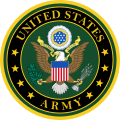| 3rd Medical Command (Deployment Support) | |
|---|---|
 Shoulder sleeve insignia | |
| Active | 5 May 1942-6 October 1945 15 March 1991 – Present |
| Country | United States |
| Allegiance | US Army Reserve |
| Branch | U.S. Army |
| Reserve Center | Forest Park, Georgia |
| Nickname(s) | ”Desert Medics" [1] |
| Motto(s) | Frontline Surgeons |
| Medical Corps colors | Maroon and White |
| Engagements | World War II Operation Desert Storm Operation Iraqi Freedom Operation Freedom Sentinel |
| Decorations | Meritorious Unit Commendation [2] |
| Commanders | |
| Current commander | MG Joseph Marsiglia |
| Insignia | |
| Distinctive unit insignia |  |
The 3rd Medical Command (Deployment Support) (MCDS) or "Desert Medics" [1] is headquartered in Atlanta, GA and manages all the Army Reserve deployable field medical units east of Ohio. While the 807th MCDS covers the MTOE medical units to the west and ARMEDCOM provides command and control for all the Table of Distribution and Allowance (TDA) medical units within CONUS.
Contents
- Order of battle
- World War II
- Operation Desert Storm
- Subordinate units
- Lineage
- Unit insignia
- Shoulder sleeve insignia (SSI)
- Distinctive unit insignia (DUI)
- Unit honors
- World War II 2
- Southwest Asia
- Global War on Terrorism
- Iraq
- Unit awards
- References
- External links
Units of the 3rd MCDS provide general, surgical, dental, ambulance, behavioral health, preventive maintenance, and veterinary support to Army units and to civilian populations.


